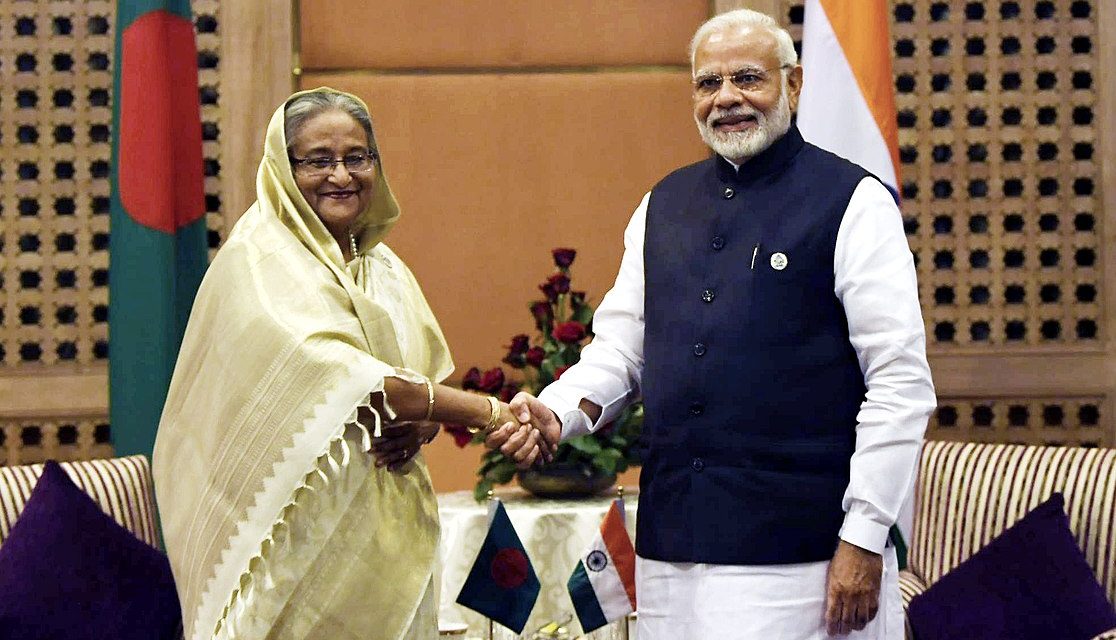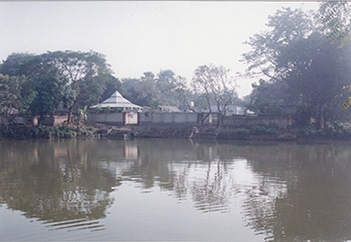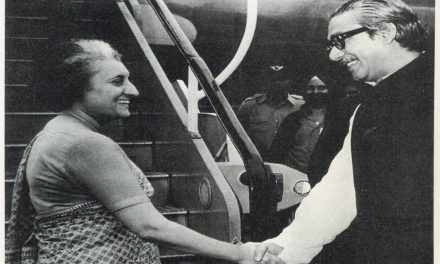Bangladesh Prime Minister Sheikh Hasina’s three-day official India visit during September 5th – 8th. The last time Hasina was in India was in 2019, three years ago, pre the Global planetary pandemic. Immense changes in the global geo-political settings have taken place. An agile time-tested relationship between Bangladesh and India is expected to take shape in this new post-pandemic paradigm.
During the visit, Prime Minister Sheikh Hasina will be formally received by Indian Prime Minister Narendra Modi. At the same time, a ceremonial guard of honour will be accorded to her. Prime Minister Sheikh Hasina will pay homage to Rajghat in honour of Mahatma Gandhi. On the same day (5th September), the Bangladesh premier will hold bilateral talks with Prime Minister Narendra Modi at the Hyderabad House. Prime Minister Sheikh Hasina is also scheduled to attend a state lunch hosted by the Hon’ble Prime Minister in her honour. Minister of External Affairs and some other dignitaries are expected to pay a courtesy call on the Hon’ble Prime Minister during her stay in New Delhi. Several Agreements and MOUs are expected to be signed during the State Visit. Prime Minister Sheikh Hasina is also scheduled to attend a business event organised by the Confederation of Indian Industries (CII). Later, she is expected to award the Mujib Scholarship, an initiative of the Government of Bangladesh, to the descendants of 200 Indian Armed Forces personnel who were martyred and critically injured during the Liberation War of Bangladesh in 1971.
Inevitably, Bangladesh Prime Minister would also discuss defence partnership and regional stability with the Indian counterpart, Narendra Modi, during the visit. Given the present circumstances of the War in Ukraine to the meltdown of Sri Lanka, a long-lasting friendly relationship is vital to ensure the path of peace and prosperity for both neighbours. The visit assumes importance in the backdrop of turbulent months in recent times that have disrupted the green shoots of post-Covid-19 economic recovery in the South Asian Region marked by episodes of saturating political and economic crisis, besides attacks of military adventurism and terrorism. India and Bangladesh mutually co-operated from medical supplies to PPE during the pandemic to ensure that both masses were insulated from the harsh realities of the Covid19 pandemic. The pandemic had left a severe dent in the economies of both countries, and only through bilateral consolidation and cooperation can it be revived back to its full potential, one the fastest in the entire SA region.
Recently, Bangladeshi’s finance minister has written to the International Monitory fund seeking a combination package including loans of 4.5 billion USD. Generally, a term that appears at face value is a bailout package. However, if examined closely, this has multiple layers and ramifications. There has been a substantial reaction to this news, especially on the Sub Continent, that maybe there is a high risk of Bangladesh being on the verge of collapse and going down a slippery slope. The memories of Colombo are fresh, and quite understandably, alarm bells are going. Much noise, but is it the scenario?
Given that Bangladesh’s current per capita income and growth rate were higher than that of her neighbours, this move seems strange, a bit of a misnomer. To be put in perspective, Bangladesh is perhaps the closest and the most valuable friend and partner of India when it comes to the neighbourhood first doctrine. What’s happening in Bangladesh is the immediate concern as it’s the third in the subcontinent to have approached the IMF. After Sri Lanka and Pakistan, and now Bangladesh, it’s irrefutable that there is considerable stress in the region. It is also to be borne in mind that apart from these, three countries which have already approached the IMF are Africa, Ghana, Tanzania, Zambia and Ethiopia. Bangladesh is a young country celebrating the golden jubilee of her independence from West Pakistan on 16th December 1971.
As a functioning democracy, it has all the essential ingredients, including fault lines. It is a large free section of media and press which regularly comments on and observes the state of affairs, as in any democracy. Finance minister AHM Mustafa Kamal has sought a package from Kristalina Georgieva (Director IMF) asking for this facility. In recent years Bangladesh has been one of the fastest growing economies, with a GDP of 416 Billion USD. The package from IMF includes a Resilience and Sustainable facility, as IMF has a pool revere to less developed countries on the front line of climate change. Bangladesh is fighting climate change as it has low-lying lands which are adversely affected by flooding and bear the brunt of global climate change. Hence, countries that are highly likely to be affected can approach the IMF to set up resilience and mitigation funds from a position of vulnerability.
It is estimated that up to 1 to 1.5 Billion USD can be sourced from this effectively interest-free fund. In addition, Bangladesh is seeking an accompanying program of around 3 to 3.5 billion USD, first to beef up the foreign exchange reserves and secondly to cater to sustainability and support from a financial point of view. Bangladesh is doing it by pre-empting the highly fluid global circumstances post the Covid19 pandemic and the Ukraine war. As a well-run government, that is exactly what you do and demonstrates agile smartness in approaching the IMF early. The foreign exchange reserve of Bangladesh has receded this year to around 39.7 Billion USD compared to last year of 45.5 Billion USD. Compared to the GDP percentage, it is irritating but not catastrophic given the present conditions globally. Bangladesh is being extra cautious and most certainly not in a crisis.
However, suppose the fuel bill goes up. In that case, it’s an apt strategy to shore up defences to address that eventuality. In September, the IMF visit will take pace to advise on the next course of action. The government has made hard decisions to shut down diesel-fired power plants, effectively curbing import bills. Cutting fuel subsidies might also be on the cards. However, Bangladesh also has a considerable amount of natural gas deposits, which can make a soft landing. There could be a more amicable and managed supply of fuel like diesel and electricity from neighbouring India to meet the energy needs of Bangladesh.
The Prime Ministers of the two countries could jointly open a 1,320 MW power plant set up by the Bangladesh-India Friendship Power Company Limited as a joint venture in Bangladesh. Rivers are one of the most notable shared resources between the two countries. The issue of water management and sharing is crucial in the bilateral cooperation agenda of Delhi and Dhaka, as India and Bangladesh share 54 rivers. The two countries have identified seven of these rivers for developing the framework of water-sharing agreements on priority. The Bangladesh PM may seek assistance from India to fight its economic crisis and accelerate economic recovery. During the upcoming visit of the Bangladesh Prime Minister, Bangladesh is likely to initiate talks for having an India-Bangladesh Comprehensive Economic Partnership Agreement (CEPA). India had provided food, gas, and oil aid (a gesture of goodwill to her neighbours, standing shoulder to shoulder at troubled times) to Sri Lanka, Nepal, Bhutan and Afghanistan. Therefore, it can be safely assumed that Bangladesh will get a certain amount of rice and gas assistance from India after Sheikh Hasina’s visit. The safety and security of Bangladesh’s energy needs is a vital ingredient for the success of the Hasina Model of economic upliftment of millions in Bangladesh.
The bilateral defence cooperation came into focus last month when the Indian Army Chief visited Bangladesh amid speculation that Indian weapons could further equip the military forces of Bangladesh. The defence cooperation between the two countries is imperative because of vulnerabilities due to geo-political instability in Myanmar and uncalled-for provocations from external forces in the northeast. This is also important to combat terrorism in the region.
Connectivity of the Indian North East Seven sisters to the ASEAN region in association with Bangladesh will also be one of the key drivers in the trade negations. The Bengal Initiative for Multi-Sectoral Technical and Economic Cooperation (BIMSTEC) can achieve its full potential once transit facilities can operate seamlessly in conjunction with the recently constructed Padma Bridge, connecting south-western Bangladesh, including the Mongla Seaport with the rest of the country as well as India. Given the excellent track record of negotiation and dialogue, the two country’s leaders might go a step forward in the coming times in resolving the Teesta waters issue and other transboundary streams alongside motorised vehicle movements to and from Nepal and Bhutan through the Indian territory and BBIN initiatives.
India and Bangladesh share an inseparable umbilical cord attachment. It saw its finest moment on 16th December 1971 when evil forces of tyranny, oppression and genocide bowed down to the synergistic forces of Mukti Bahini and Indian armed forces, the largest surrender since the second world war. The present leadership must ensure and enshrine this solemn bond of blood at the very core of this partnership.
Image courtesy: GODL-India
















